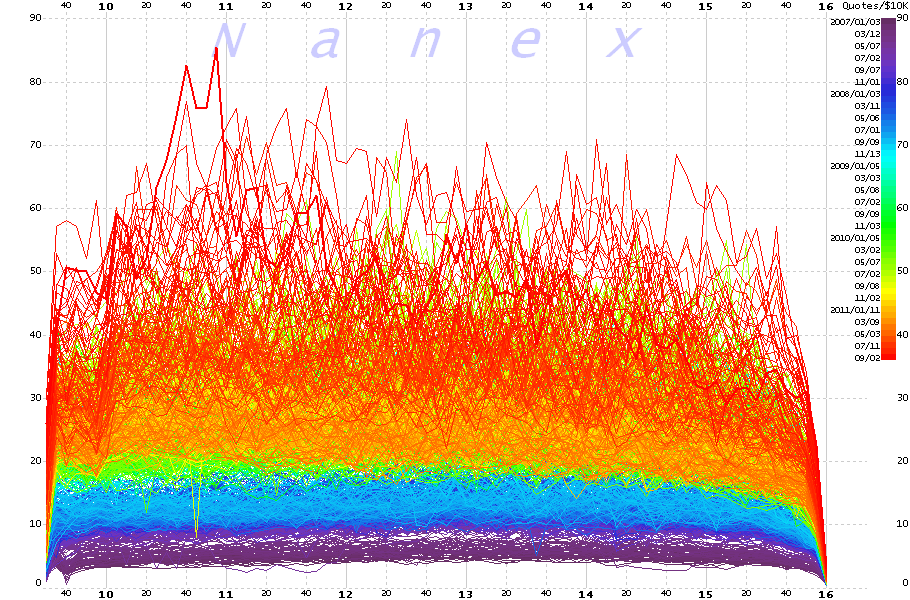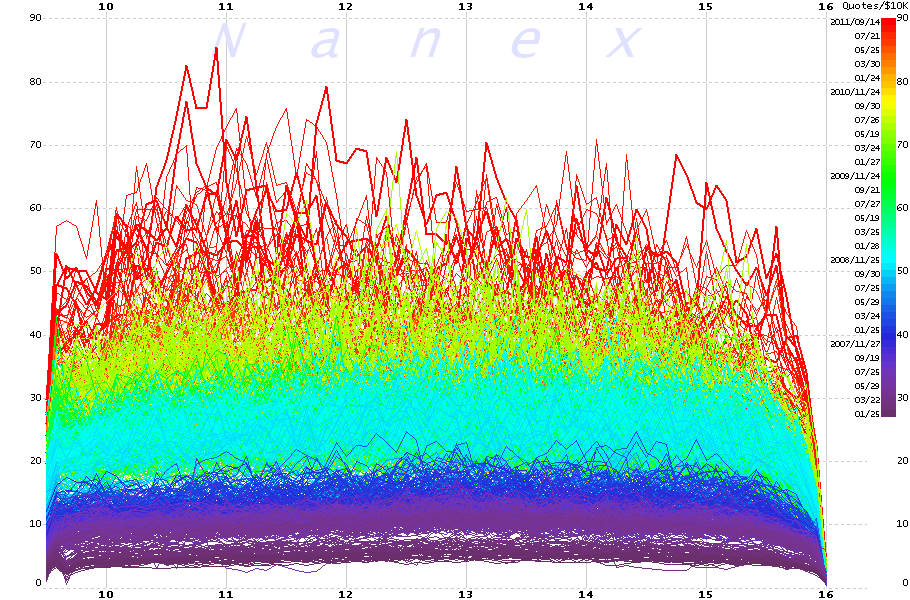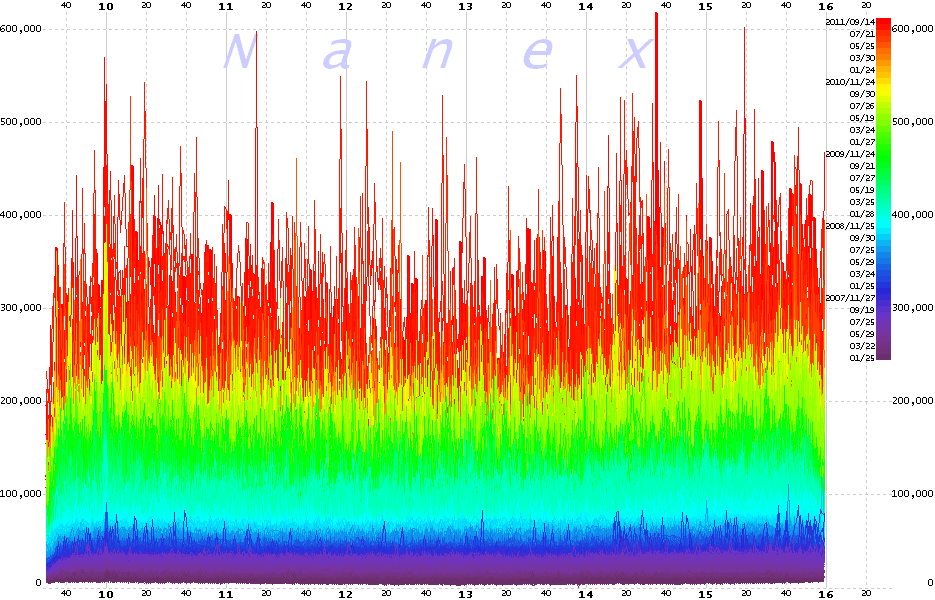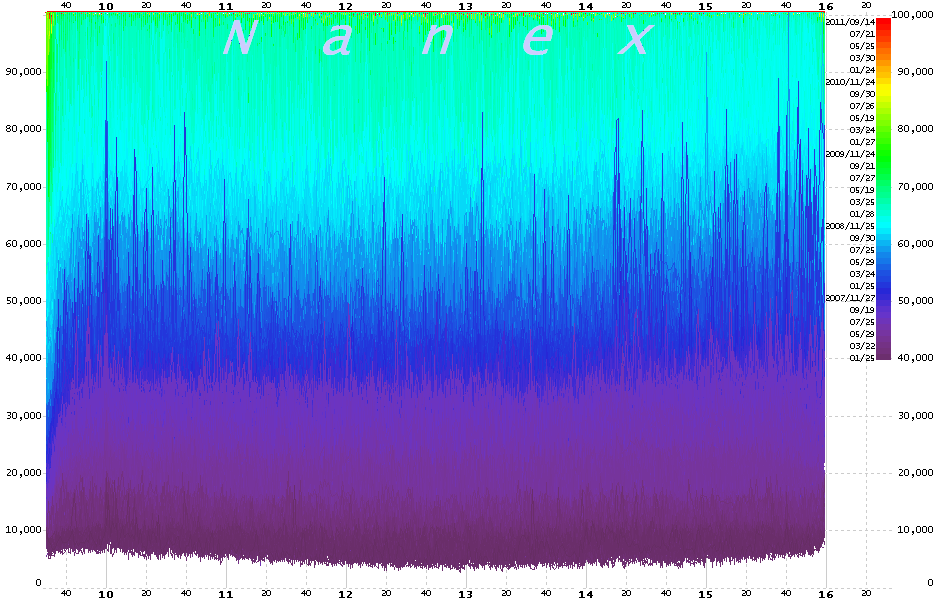The chart below shows how many quotes it takes to get $10,000 worth of stock
traded in the U.S. for any point in time during the trading day over the last 4.5 years. Higher numbers indicate a less efficient market: it takes more
information to transact the same dollar volume of trading.
Quote traffic, like
spam, is virtually free for the sender, but not free to the recipient. The cost
of storing, transmitting and analyzing data, increases much faster than the
rate of growth: that is, doubling the amount of data will result in much more than
a doubling of the cost. For example, a gigabit network card costs $100, while a 10
gigabit network card costs over $2,000. A gigabit switch, $200; a 10 gigabit switch,
$10,000. This October, anyone
processing CQS
(stock quotes) will have to upgrade all their equipment from gigabit to 10 gigabit. Which would be fine if this was due to
an increase in meaningful data.
We think that a 10-fold increase
in costs without any benefits would be considered "detrimental" by most business
people.
This explosion of quote traffic relative to its economic value is accelerating.
Data for September 14, 2011 is the thicker red line that snakes near the high.
There is simply no justification for the type of quote data that underlies this
growth. Only the computers spamming these bogus quotes benefit when they
successfully trick other computers or humans into revealing information, or
executing trades. This is not progress. Progress is almost always accompanied
by an increase in efficiencies. This is completely backwards.
And to anyone who might say:
"To my knowledge there's been no proof shown that
high-frequency trading has been detrimental.",
we'd like to submit this paper as Exhibit A. We think that a 10-fold increase in costs
without any benefits would be considered
"detrimental" by most business people. We think the regulators would agree with us as well. In fact, they already have on this
very topic:
Section I.C.4 of Reg NMS (page 30) states:
Accordingly, one of the Commission's most important responsibilities
is to preserve the integrity and affordability of the consolidated data stream.
And from the same document (page 410):
But in those limited contexts where the interests of long-term investors
conflict with short-term trading strategies, the conflict cannot be reconciled by
stating that the NMS should benefit all investors. In particular, failing to adopt
a price protection rule because short-term trading strategies can be dependent on
millisecond response times would be unreasonable in that it would elevate such strategies
over the interests of millions of long-term investors – a result that would be directly
contrary to the purposes of the Exchange Act.
|
5-minute Average of the Number of Quotes per $10,000 in Trade Transactions.
Time scale shows hour and minute of the trading day (9:30 to 16:00 Eastern).
Each trading day between January 1, 2007 and September 14, 2011 is color coded by
date: older dates are colored towards the violet end of the spectrum, while more recent
dates are colored towards the red end of the spectrum. The most recent day is plotted
as double thick red line.
We had to process 535 billion quotes and 35 billion
trades over 1,172 trading days to generate this chart.
|

Same data as image above, but plotted in reverse order
|

1-Second Peak U.S. Equity Quote Rate Showing a 100-fold Increase Since January 2007
|


|
Inquiries: pr@nanex.net
Publication Date: 09/15/2011
http://www.nanex.net
| This report and all material shown on this
website is published by Nanex, LLC and may not be reproduced, disseminated, or
distributed, in part or in whole, by any means, outside of the recipient's
organization without express written authorization from Nanex. It is a
violation of federal copyright law to reproduce all or part of this publication
or its contents by any means. This material does not constitute a solicitation
for the purchase or sale of any securities or investments. The opinions
expressed herein are based on publicly available information and are considered
reliable. However, Nanex makes NO WARRANTIES OR REPRESENTATIONS OF ANY SORT
with respect to this report. Any person using this material does so solely at
their own risk and Nanex and/or its employees shall be under no liability
whatsoever in any respect thereof. |
|
|
|










